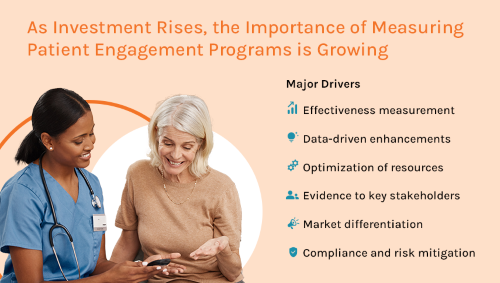A seismic shift has occurred in the healthcare landscape. As proactive advocates of their own health with unlimited access to information, today’s patients seek more from the pharmaceutical industry than ever before. They are savvy consumers who seek holistic support beyond the medication, customization and personalization of services, and seamless integration of live and digital tools.

Delivering on these heightened expectations has fueled the urgency to invest in patient engagement and support. As pharmaceutical companies channel ever-increasing resources into these transformative initiatives, the need for robust and comprehensive measurement becomes not just an option, but an imperative, in order to validate allocation of resources and effectiveness of the investment.
A well-structured measurement plan is essential for evaluating the impact of a patient engagement program. It enables companies and their solution providers to make sure relevant data is identified, captured, analyzed, and reported. It also helps verify that changes and improvements are incorporated to increase effectiveness and deliver on the objectives the brand intended. Objectives must be clear, measurable, and align with the program's intended outcomes. Setting baselines or benchmarks before implementing the patient engagement program creates reference points for assessing impact and effectiveness over time.
Data Points: Leading and Lagging Indicators
Measurement indicators for a patient engagement program fall into two categories: leading and lagging indicators. Leading indicators are early signals that assess the program's potential success or effectiveness before measurement of final outcomes. They are often categorized as activity data, such as the volume of patients who opt in to receive support or survey data which is helpful to measure changes in knowledge, confidence, and motivation of patients.
While leading indicators provide signals, the most robust measurement studies look at the lagging indicators for performance. These are the key performance indicators (KPIs) that reflect the main goals of the program and can often be translated into a financial benefit for the pharma company. Examples include:
- Increased first-fill rate of program participants.
- Improved persistency and continued fill rate of patients in the program.
- Superior patient experience, often measured as an NPS score, which determines the likelihood of patients recommending the program to others.
- Decrease in cost by evaluating overall healthcare costs including hospitalization rates.
- Patient-reported outcomes used to measure the impact of a patient's health condition and treatment on their overall quality of life.
Unlike traditional clinical measures that focus solely on disease-specific outcomes, these patient-reported outcomes capture the patient's perspective, subjective experiences, and well-being in relation to their health and treatment.
Innovative Advanced Analytics Solutions
Greater access and focus on data has created innovation around advanced analytics solutions that are working to better program impact, identify opportunities for optimization and mine for front-line patient insights. Three solutions in particular have seen broader adoption:
- Predictive Models: These are statistical models that use a variety of patient data, demographic, psychographic, medical history etc. to make predictions about future patient outcomes, behaviors, or needs. The model is designed to analyze patterns and relationships within the data and then apply those patterns to new data to make informed predictions. In the context of patient engagement programs, predictive models aim to anticipate patient needs and optimize interventions.
- Next Best Action engines: These machine learning applications use advanced algorithms and data analytics to suggest the most appropriate and personalized course of action for a specific situation or individual at a given time.
- Natural-Language Processing (NLP) insights: This refers to insights gleaned from valuable information and patterns extracted from unstructured text data. NLP is a subfield of artificial intelligence that focuses on the interaction between computers and human language. It enables machines to understand, interpret, and generate human language, allowing for the analysis of vast amounts of text data that can be captured through the delivery and measurement of patient engagement programs.
Taking the Next Step
In an era of soaring investment into patient engagement programs by pharma, embracing data helps to validate the sizeable investment in patient support. The key to unlocking the true potential of patient support lies not only in the size of the investment but in the depth of its impact assessment.
As we look to the future, let us embrace the potential of data-driven approaches and innovative tools in patient engagement. Together, we can create a healthcare landscape that not only improves patient outcomes but also fosters a stronger and more connected healthcare ecosystem. Through a commitment to data-driven excellence, we make a lasting impact on patient lives and the healthcare community.
Reach out at [email protected] for a copy of our full whitepaper on the subject of measurement of patient engagement programs. Visit vmsbiomarketing.com for other insight into the industry’s patient-engagement evolution.
Josh Konetzni
Senior VP, Business Development
VMS BioMarketing